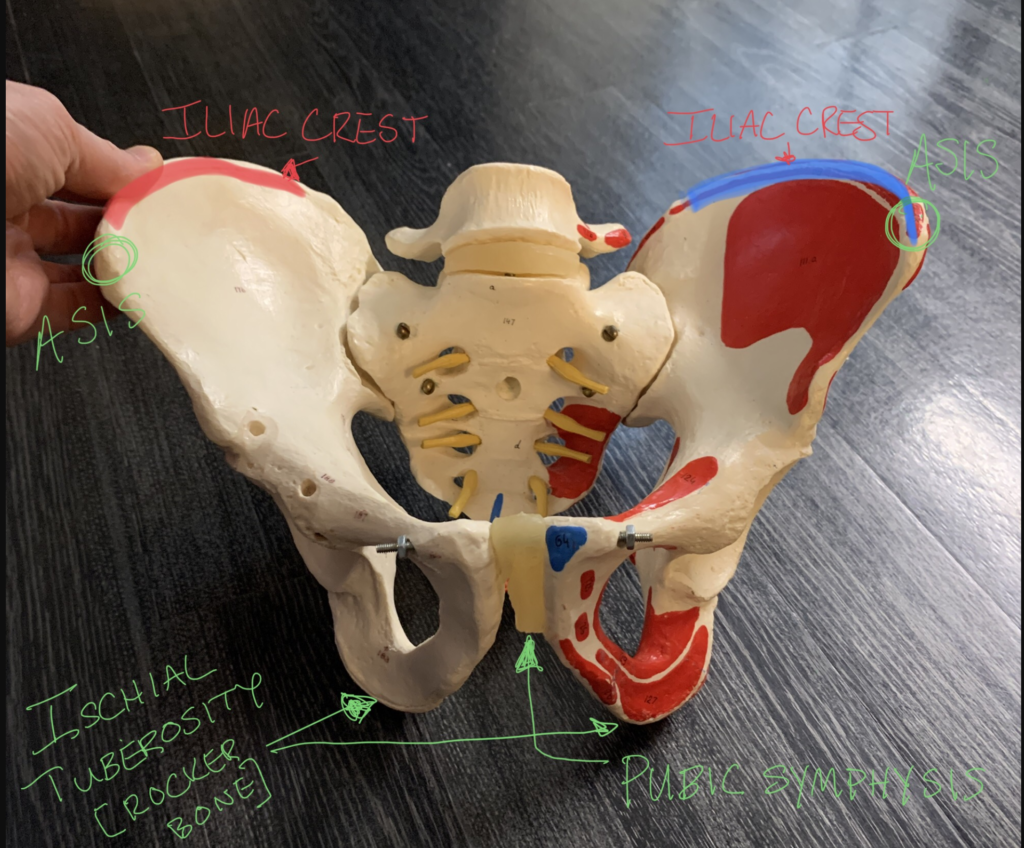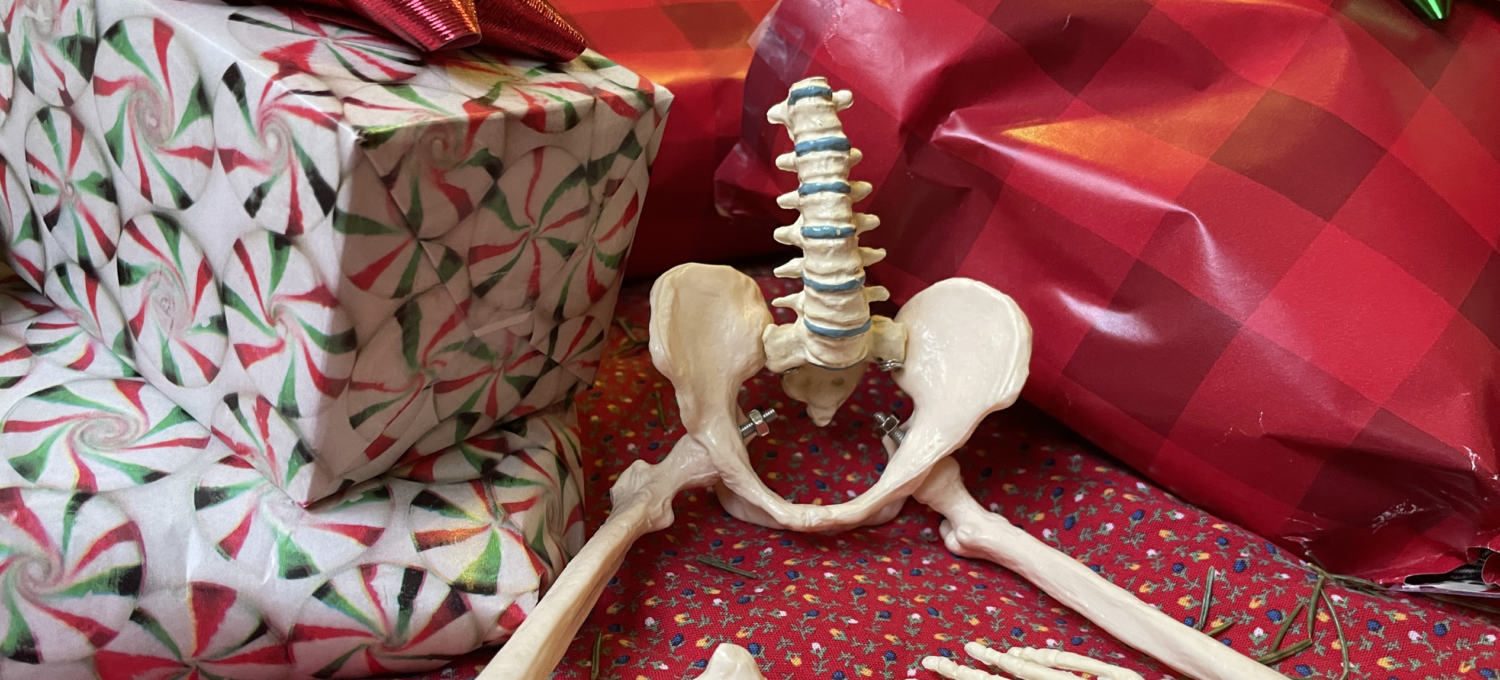The focus of the second article in the series is the differences between types of movement that happen at the pelvis. If you haven’t read the first article (https://thefluteexaminer.com/the-importance-of-the-pelvis-part-1/) from our November 2020 issue, please take a look at that as I will be using anatomical terms that were explained there. There should be no pain or discomfort as you try the following movements. If there is, please stop immediately. There is a link to a short video demonstrating these movements at the end of the article, as this material is much easier to figure out when you can actually see somebody moving!
Starting Position
For each of these movements, you will start by standing up with equal weight on both feet. Your pelvis should be backed up over your ankle joints. Many people go about their daily lives with their pelvis shoved forward in space, over the top of the forefoot instead of the ankles. If your pelvis is shoved forward, it is likely that you feel more weight in the balls of your feet and less in the heels. In an ideal situation, there’s equal weight distribution front to back, as well as between both feet.
Pelvic Tilt
Stand up and imagine that you are holding a big bowl of imaginary soup in front of you. Your hands on the rim of the bowl. Move your hands as if you were going to dump the soup out away from your body. That is anterior tilt—your fingers are going down in front while your thumbs are moving up in back. Now, dump the imaginary soup back towards your belly. This is posterior tilt. Your thumbs are going up in the back and fingers are going down in the front.
Now place your hands on your iliac crests, the bony ridge of your pelvis on your sides. Your thumbs should be pointing back and your fingers are pointing to the front, same as on your imaginary soup bowl. Move your pelvis into anterior tilt – front of your pelvis and fingers go down and back of your pelvis and thumbs come up. Then move into posterior tilt – the back of your pelvis and thumbs goes down and the front of your pelvis comes up. Notice what is happening with your lower back. With anterior tilt, the curve in the lower back becomes more pronounced. With posterior tilt, the curve in the lower back flattens out. It’s helpful to look at yourself from the side in a mirror to see what’s happening here.
These same motions can be done while lying on the floor on your back with knees bent. Anterior tilt of your pelvis increases the curve in lower back and there’s more space between your body and the floor. For posterior tilt, there is less space as the curve in the lower back flattens out.
Neutral position for the pelvis is somewhere in between the two extremes of anterior and posterior tilt. Revisit the ASIS points at the top front of the pelvis and pubic symphysis at the bottom. Here’s the photo again with the bony landmarks labeled. Think of a triangle with the tip pointed down. Neutral position is when the three points are all on the same vertical plane. With anterior tilt, the top two points (ASIS points) are out in front of the bottom point (pubic symphysis). With posterior tilt, the bottom point is out in front of the top two points.

Shifting
For rest of the movements, look at the front of your body in a mirror. Start with standing with equal weight on both feet and pelvis over ankles. Slowly shift your whole pelvis to the left, back to center, then over the right, and back again to center. Don’t go so far that your feet come off of the floor. Try to keep your torso and head facing the forward, they should be relatively stationary. Only your pelvis is shifting, not the pelvis + torso + head.
Hikes and Drops
Start, again, with standing with equal weight on both feet and pelvis over ankles. Bend your left knee and keep your right leg straight. The left side of your pelvis, the bent knee side, will drop down towards the floor. The right side side of your pelvis, the straight leg side, will hike up towards the ceiling. There will be a shortening of your left side and a lengthening on the right side. Come back to the starting position and do the other side. Right knees bends, right side of pelvis drops, shortening on the right side of torso. Left leg stays straight, left side of pelvis hikes, and lengthening on the left side of torso.
Rotation
Start standing with equal weight on both feet and pelvis over ankles. Your entire pelvis is going to rotate to the right, while your ribs and head keep facing front. Return to the starting position and repeat to the other side. Your entire pelvis rotates to the left, ribs and head facing front.
Click here video link of movement demonstrations.
Movement Combination
All of the movements of the pelvis happen in ordinary, every day walking. They are part of the human gait cycle. Go for a short walk, preferably outside, but you can walk in your inside space too. Without changing anything, can you notice these movements? It’s not so easy as noticing them in isolation because they are happening together!
Playing Experiment
Try playing your flute while doing the various movements of your pelvis. I recommend starting with long tones or scales, something that’s not super busy with fingers, for now. You might find that some of these movements are very easy and familiar with flute in hand and others might be completely foreign. The goal is to just experiment and notice what is possible.
Many flutists play with most of their weight on the left foot and this often goes along with a shift of the pelvis to the left. Some flutists have the opposite habit—more weight on right foot and shift of pelvis to the right. For many flutists, there is some rotation of the pelvis to the right as the flute comes into playing position. Many people find that they are chronically stuck in posterior pelvic tilt and this goes along with sitting a lot. Most chairs, car seats, and seats on public transportation force until this tucked under position becomes the default. Some flutists will find that they go into extreme anterior pelvic tilt when playing and the excessive curve in the lower back is easy to see.
Revisit Global Connection Experiment #1 from the November issue. Notice that when rocker bones are going straight down into the chair, the pelvis is relatively neutral. ASIS points and pubic symphysis, the three points of the triangle, are organized on the same vertical plane. When you roll back on your rocker bones, into the C-shaped position, your pelvis in in posterior tilt. When you rock forward on your sitting bones, you’re going into more of an anterior pelvic tilt.
So what?
The next article in the series is going to talk about some of the muscles that connect the pelvis to other body parts. Flutists tend to be very interested in anything that improves breathing and arm use and some of these connections are influenced by what movement choices you’re making with your pelvis. For now, the goal is to simply notice that there are lots of ways your pelvis can move. Stay tuned!


Hi, This is a lovely summation of muscular balance issues with the pelvis. However, I want to point out that there can be significant bony, skeletal differences ie. dysplasia, which can contribute a confusing picture to flutists who are trying to rebalance themselves. Dysplasia is not uncommon (especially with dancers, gymnasts, and flexible people), and badly undiagnosed/under-diagnosed, and people with dysplasia often have frustrating conversations with PTs, yoga instructors etc. on why things don’t work in spite of muscular adjustments. I’m hoping that in future performers will become more educated about the variabilities of skeletal issues, so that we can become our own best advocates.
I absolutely agree that there are bony, skeletal differences among people. I like to remind my students often that the skeletal images they are seeing are all averages and nobody looks exactly like the picture!